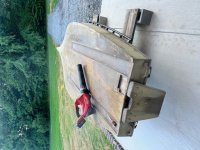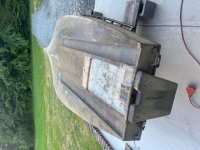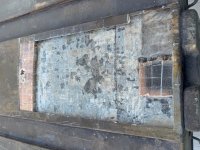Noah Shaver
Member
You guys ever start a project that's supposed to be a simple easy fix, only to have the scope of the project grow exponentially when you get into it?
That's where I'm at right now!
I bought this boat back in November from Central PA. It had a patch in the hull near the transom that needed to be repaired. All of the surrounding material passed the screwdriver prod test, so I figured this was going to be a fairly simply patch and this boat would be hunting in no time. Boy was I wrong.
I got the boat flipped over Friday and started working on preparing the area for the patch. This is when I found out that the surrounding material only felt hard because of the epoxy used for the previous patch. Get outside of the patched area and the material is wet and soft.
Some of the old balsa core is sopping wet, you can almost wring water out of it with your fingers. The crazy part is the boat hasn't been in the water in 8 years, and the material is still wet.
Removing this old balsa core sure is a pain. I started by cutting the fiberglass on the bottom of the boat and removing, but the first layer of glass is still bonded to the balsa core. I took my angle grinder and cut a grid pattern into the balsa core to make it easier to remove, and started with a hammer and a Chisel or a long flathead screwdriver.
This method works but is painstakingly slow. Yesterday I picked up some scraper blades for my oscillating saw and this speeds things up greatly. You still have some manual labor involved, but you can get the balsa core out in chunks instead of little pieces.
I haven't found the end of the wet material yet. I fear that I'm going to chase this all the way to the bow.
Here she is at the start:

And as she sits now:


That's where I'm at right now!
I bought this boat back in November from Central PA. It had a patch in the hull near the transom that needed to be repaired. All of the surrounding material passed the screwdriver prod test, so I figured this was going to be a fairly simply patch and this boat would be hunting in no time. Boy was I wrong.
I got the boat flipped over Friday and started working on preparing the area for the patch. This is when I found out that the surrounding material only felt hard because of the epoxy used for the previous patch. Get outside of the patched area and the material is wet and soft.
Some of the old balsa core is sopping wet, you can almost wring water out of it with your fingers. The crazy part is the boat hasn't been in the water in 8 years, and the material is still wet.
Removing this old balsa core sure is a pain. I started by cutting the fiberglass on the bottom of the boat and removing, but the first layer of glass is still bonded to the balsa core. I took my angle grinder and cut a grid pattern into the balsa core to make it easier to remove, and started with a hammer and a Chisel or a long flathead screwdriver.
This method works but is painstakingly slow. Yesterday I picked up some scraper blades for my oscillating saw and this speeds things up greatly. You still have some manual labor involved, but you can get the balsa core out in chunks instead of little pieces.
I haven't found the end of the wet material yet. I fear that I'm going to chase this all the way to the bow.
Here she is at the start:

And as she sits now:


